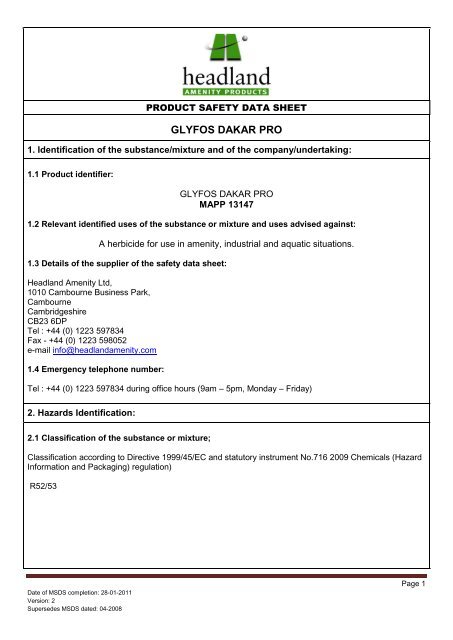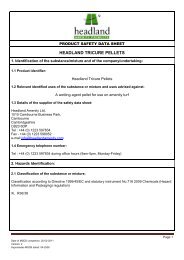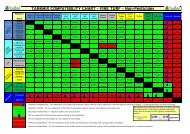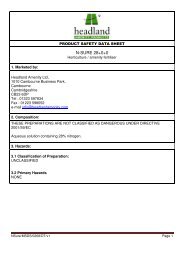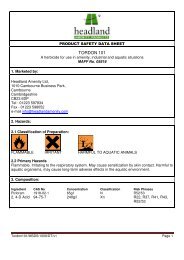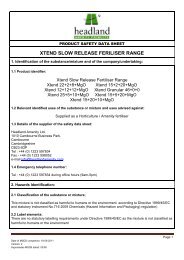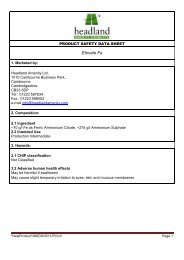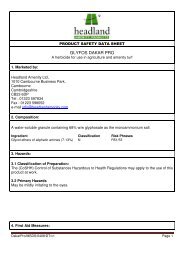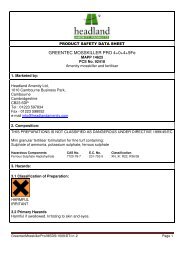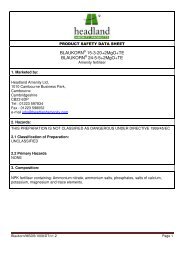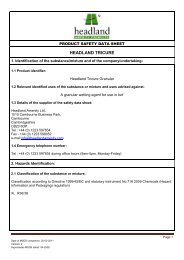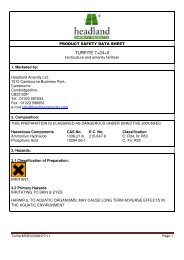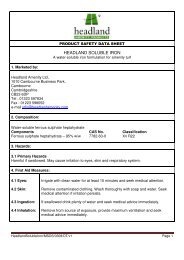You also want an ePaper? Increase the reach of your titles
YUMPU automatically turns print PDFs into web optimized ePapers that Google loves.
<strong>PRO</strong>DUCT SAFETY DATA SHEET<strong>GLYFOS</strong> <strong>DAKAR</strong> <strong>PRO</strong>1. Identification of the substance/mixture and of the company/undertaking:1.1 Product identifier:<strong>GLYFOS</strong> <strong>DAKAR</strong> <strong>PRO</strong>MAPP 131471.2 Relevant identified uses of the substance or mixture and uses advised against:A herbicide for use in amenity, industrial and aquatic situations.1.3 Details of the supplier of the safety data sheet:<strong>Headland</strong> <strong>Amenity</strong> Ltd,1010 Cambourne Business Park,CambourneCambridgeshireCB23 6DPTel : +44 (0) 1223 597834Fax - +44 (0) 1223 598052e-mail info@headlandamenity.com1.4 Emergency telephone number:Tel : +44 (0) 1223 597834 during office hours (9am – 5pm, Monday – Friday)2. Hazards Identification:2.1 Classification of the substance or mixture;Classification according to Directive 1999/45/EC and statutory instrument No.716 2009 Chemicals (HazardInformation and Packaging) regulation)R52/53Date of MSDS completion: 28-01-2011Version: 2Supersedes MSDS dated: 04-2008Page 1
2.2 Label elements:GLFOS <strong>DAKAR</strong> <strong>PRO</strong>MAPP 13147Contains 68% w/w Glyphosate as monoammonium saltRisk Phrases:R52/53: Harmful to aquatic organisms, may cause long-term adverse effects in the aquaticenvironmentSafety Phrases:S35: This material and its container must be disposed of in a safe way.S57: Use appropriate containment to avoid environmental contamination2.3 Other hazards:None Known3: Composition/information on ingredients:3.2 MixturesHazardous Components CAS-No./ EC No. Concentration ClassificationGlyphosate as monoammonium salt - - 68% N; R51/53The full text for all R-Phrases if not displayed in section 2 or 3 are displayed in Section 16.4. First Aid Measures:4.1 Description of first aid measures:Eyes:Skin:Ingestion:Inhalation:Irrigate gently with clean water for at least 15 minutes. Remove contact lenses ifpresent and easy to do so after 5 minutes. Obtain immediate medical attentionpreferably from an ophthalmologist.Remove contaminated clothing. Wash thoroughly with soap and water. Seek medicaladvice if any irritation or redness persists or develops later.Do NOT induce vomiting. Give water to drink. Obtain immediate medical attention/send to hospital immediately. The decision whether to induce vomiting or not should bemade by attending doctorRemove from source of exposure into fresh air. Consult a physician.4.2 Most important symptoms and effects, both acute and delayed:No further information available4.3 Indication of any immediate medical attention and special treatment needed:This product contains a glycine herbicide of low acute toxicity. Treatment should be symptomatic andsupportive. There is no specific antidote. Ingestion may cause irritation of the gastro-intestinal tract and themouth, with nausea, vomiting and diarrhoea. Ingestion of large quantities of a similar product has beenreported as resulting in hypertension and lung oedema.Page 2
5. Fire Fighting Measures:5.1 Extinguishing MediaThe product will not burn, use dry chemical, foam, water fog, water fine spray, carbon dioxide or Drychemical powder as appropriate fro surrounding materials. Contain any material used in fire fighting.5.2 Special hazards arising from the substance or mixtureIf involved in a fire, fumes and vapours will be harmful and may include oxides of carbon, nitrogen andphosphorous. Prevent entry of the product or firefighting water into watercourses, ditches or drains bybunding the area with sand or earth if possible. Inform the water authorities if contamination of water isthreatened or occurs.5.3 Advice for fire-fighters:Suitable protective clothing and self-contained breathing apparatus. Keep contains cool by spraying withwater.6. Accidental Release Measures:6.1 Personal precautions, protective equipment and emergency procedures:Wear suitable protective clothing and eye/face protection (See section 8).6.2 Environmental precautions:Prevent entry of the product or contaminated water into watercourses, sewers or drains. Inform the properauthorities if gross contamination of water is threatened or occurs.6.3 Methods and material for containment and cleaning up:Sweep carefully into suitable container for re-use or dispose at an approved site. Small spillages should bewashed thoroughly with water.6.4 Reference to other sections:No reference7. Handling and storage:7.1 Precautions for safe handling:Use good personal hygiene. DO NOT consume or store food in the work area. Wash hands and exposedskin before eating, drinking or smoking and after work. Avoid contact with eyes, skin and clothing.7.2 Conditions for safe storage, including any incompatibilities:Keep in original container, tightly closed. Keep cool and dry in a suitable agricultural chemical store underlock and key. DO NOT store in direct sunlight. Keep away from food, drink and animal feeding stuffs andout of reach of children. DO NOT store, mix or apply this product or dilute solutions of it in galvanisedor unlined steel containers or sprayer tanks. Use only stainless steel, aluminium, fibreglass, plastic(HDPE or PET) or plastic-lined containers.7.3 Specific end use(s):No further information availablePage 3
8. Exposure controls/personal protection:8.1 Control ParametersNo applicable exposure limit Values determined8.2 Exposure ControlsWear coveralls, suitable chemical resistant gloves and safety goggles when handling the concentratedproduct or contaminated surfaces and dealing with spillages.9. Physical and Chemical Properties:9.01 Appearance:9.02 Odour:9.03 pH:9.04 Boiling Point / Range9.05 Flash Point / Flammability:9.06 Explosive Properties:9.07 Oxidising Properties:9.08 Vapour Pressure:9.09 Relative Density:9.10 Solubility:9.11 Partition Coefficient:9.12 Viscosity:9.13 Vapour Density:9.14 Evaporation Rate:A white solid granuleFaint, amine like4 (1% aqueous suspension)Information not availableNot classified as flammableNot classified as explosiveNot classified as oxidising1.75 x 10 -7 mm Hg at 25 o C (Glyphosate)Tap density: 0.73g/cm 3Completely soluble in waterP=4.5 x 10 -4 (glyphosate)Information not availableInformation not availableInformation not available9.2 Other InformationNo other relevant information available10. Stability and Reactivity:10.1 Reactivity:Will react with galvanised or unlined steel to produce hydrogen and highly combustible gas mixtures mayform which could flash or explode causing severe injury.10.2 Chemical Stability:Stable under normal storage conditions10.3 Possibility of hazardous reactions:None known.Page 4
10.4 Conditions to avoidExtremes of temperature10.5 Incompatible materialsAvoid contact with strong alkalis. Avoid galvanised or unlined steel10.6 Hazardous decomposition productsSee section 10.1. other decomposition products not known11. Toxicological Information:11.1 Information on toxicological effects:Acute Oral LD50:>5000 mg/kg (Rat).Swallowing large amounts may cause injury and may cause central nervoussystem effectAcute Dermal LD50:InhalationIrritancy:>5000 mg/kg.Information not availableMildly to moderately irritating to eyes. It can have irritating effects on skin andthe upper digestive and respiratory tract12. Ecological Information12.1 Toxicity:Classified as Harmful to the environment in accordance with the CHIP regulations 2009 and Directive1999/45/EC.This product is a herbicide and, therefore, toxic to all green plants. It is harmful to fish, aquatic invertebratesand aquatic plants.LC50 (96 hour): Rainbow Trout >100mg/lEC50 (48 hour): Daphnia spp >100mg/lEC50 (72 hour): Desmodesmus >100mg/l (growth)=91.6mg/l (biomass)LD50: Bobwhite Quail >2000mg/kg.bw (glyphosate)LD50 (48 hour): Bee >100μg/bee12.2 Persistence and Degradability:Slow to bio-degrade in the environment and waste water treatment plants. Microbial activity is the maindegradation mechanism but aerobic and anaerobic degradation also occur.12.3 Bioaccumulative potential:Unlikely to bio-accumulation12.4 Mobility in soil:Strongly binds to clay particles. Not mobile.12.5 Results of PBT and vPvB assessment:Mixture not assessed12.6 Other adverse effects:No other adverse effects knownPage 5
13. Disposal Considerations:13.1 Waste treatment methods:Disposal of Used Mixture:Consult the local authorities before disposing of unwanted chemical. It is recommended that the chemical ismixed with a combustible solvent and burned in a chemical incinerator equipped with an afterburner andscrubber.Disposal of Packaging:Dispose of containers by burning or as permitted by local authorities. DO NOT re-use containers for anypurpose.14. Transport Information:Road Rail/ Sea and Air:Information not required as mixture not regulated for carriage.UN number:UN proper shipping name:Transport hazard class(es):Packing group:Environmental hazards:Special precautions for user:Transport in bulk according toAnnex II of MARPOL 73/78 andthe IBC code:15. Regulatory Information15.1 Safety, health and environmental regulations/legislation specific for the substance or mixture:This mixture is classified and labelled in accordance with Directive 1999/45/EC, Regulation 1272/2008 andthe statutory instrument No.716 2009 Chemicals (Hazard Information and Packaging) regulations.15.2 Chemical Safety Assessment:CSA not undertaken for this mixture.Page 6
16. Other InformationFull texts of Risk phrases if not displayed Sections 2.0 and 3.0.R51: Toxic to aquatic organisms.Please note that these R phrases are assigned to individual ingredient but not carried to the finalclassification of the mixture.The above information is intended to give health and safety guidance on the storage and transport of thesubstance or product to which it relates. It is not intended to apply to the use of the product, for whichpurpose the product label and any appropriate technical usage literature available should be consulted andany relevant licences, consents or approvals complied with. The requirements or recommendations of anyrelevant site or working procedure, system or policy in force or arising from any risk assessment involvingthe substance or product should take precedence over any of the guidance contained in this safety datasheet where there is a difference in the information given. The information provided in this safety data sheetis accurate to the best of the issuer’s available knowledge at the date of publication, and will be updated asand when appropriate. No liability will be accepted for any loss or damage resulting from any failure to takeaccount of information or advice contained in this safety data sheet.Reason For Update:MSDS has been re-written to reflect the new format given in Annex I of the REACH regulation 453/2010.<strong>Headland</strong> is a registered trademark of <strong>Headland</strong> AgrochemicalsGlyfos Dakar Pro is a registered trademark and product of Cheminova A/S, Lemvig, DenmarkEnd of Safety Data SheetPage 7


